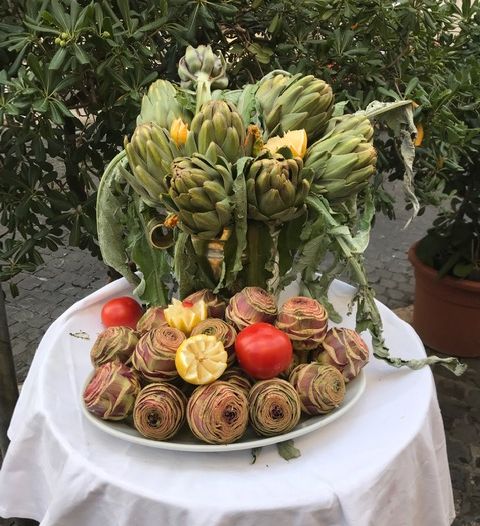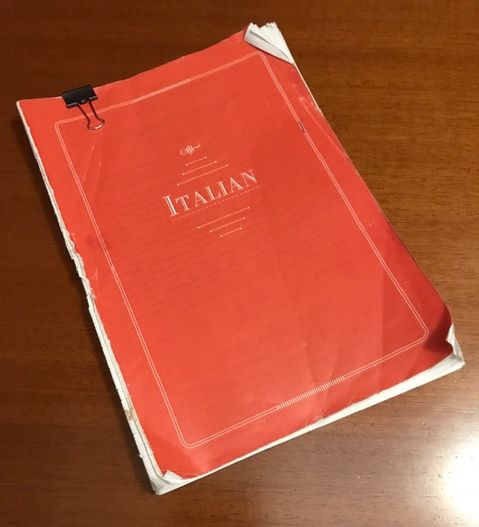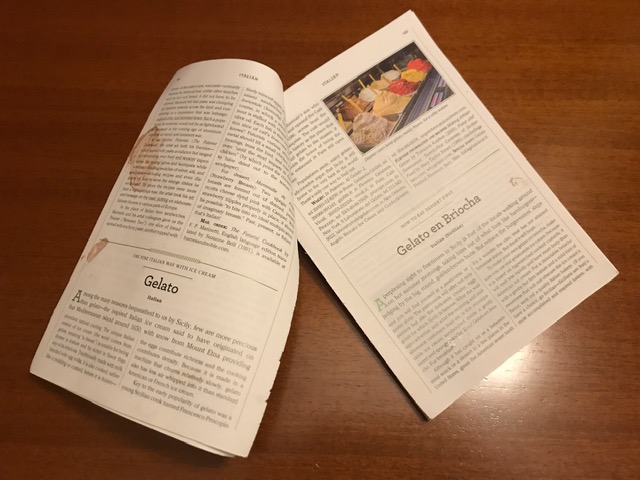Condensing the Guidebook
One morning, shortly before we left on this trip, Mary approached me with a very serious look on her face.
“I’m going to ask you to do something that I know you don’t want to do”, she said.
“OK?”, I replied, not quite certain what might be coming next.
Mary held up our copy of “1,000 Foods to Eat Before You Die”, our unofficial Guidebook. We had adopted the book, by the accomplished food writer and critic Mimi Sheraton, as our inspiration when we started this blog. We’re attempting find and taste as many of the 1,000 foods as we can. Some of them we purchase and cook at home, others we try in restaurants. This two week trip in Italy and Sicily is a great opportunity to sample some dishes that we might never find in the US.
“I want to cut up our guidebook so we only have to carry the section on Italian food.”
It’s true. She had suggested this before and I didn’t agree. Something about ruining the integrity of the book. But at this new moment, I was relieved that this was the choice to be made, and not any of the unpleasant, expensive actions that had flashed through my brain.
“Look”, she continued, “We can buy another copy when we get back. But I don’t want to carry the whole book when we only need 30 to 40 pages.”
Her logic was hard to debate. The book is over 1,000 pages, and even in paperback it would add unnecessary weight and bulk to our luggage.
“Uh, OK. That’s fine with me.” I was suddenly struck monosyllabic.
“Good. Thanks.” And off she went, probably in search of scissors or a knife.
So that’s how we ended up with this small packet of paper, held together with a binder clip. The pages are more dog-eared than ever, and the whole thing is rapidly accumulating margin notes and the occasional gelato stain.
Searching for Artichokes
On Sunday, our last full day in Rome, we set out to find and try carciofi alla Giudea, a deep-fried artichoke that originated in the Jewish Ghetto of Rome.
Some background is useful here. The Jewish Ghetto was an area of Rome that was originally set aside by Pope Paul IV in 1555. For over 300 years, Roman Jews were required to live inside the ghetto walls, which were locked every evening. The area was overcrowded and subject to flooding, which often led to outbreaks of disease. Jews were also subject to a long list of restrictions, including being prohibited from owning property. The walls were torn down in the 1880’s, but much of Rome’s Jewish population continued to live in the area.
The Jewish Ghetto was a 30 minute walk from our AirBnB. It was another lovely day in Rome, so off we went. We walked past the Colosseum, now a familiar part of our landscape. But taking that route forced us to share the narrow Roman streets with thousands of tourists. (That sounds like a local’s complaint, doesn’t it?)
Once past the Colosseum, we walked across the Circus Maximus. It was once a stadium that held over 250,000 people, but now is just a large field. We thought about Ben Hur and chariot races.
Shortly after that we came to Via Al Portico d’Ottavia, one of the main streets in the Jewish Ghetto. Within half a block, we came to our destination: Hostaria Da Giggato (Via del Portico D’Ottavia 21 / a-22 , http://www.giggetto.it/ ).

It was almost 2pm, but there was still a line of people waiting to be seated. I suggested that maybe we should find someplace else, but Mary vetoed the idea. “No, this is the place where I want to eat.” We had read that this was one of the best places to get the fried artichoke.
Just then, a group ahead of us got out of line. They were 12 people and had decided that they should split up and try their luck elsewhere. That put us at the head of the line. Within five minutes we were seated at a table on the patio and had ordered lunch – a fried artichoke, pasta carbonara and a bottle of Falanghia, the same type of wine we had the night before. It was a pleasant afternoon, and we were in no hurry.
Fried artichoke is a dish we’re happy to say we’ve tried, but probably would not order again. Mimi Sheraton described them this way:
“The raw chokes are flattened and then deep-fried, to emerge looking like dried sunflowers. (Crisp, chiplike outer petals hint at the velvety, slightly bittersweet flavor of the tender heart that is the final reward.” Our Guidebook, page 174.
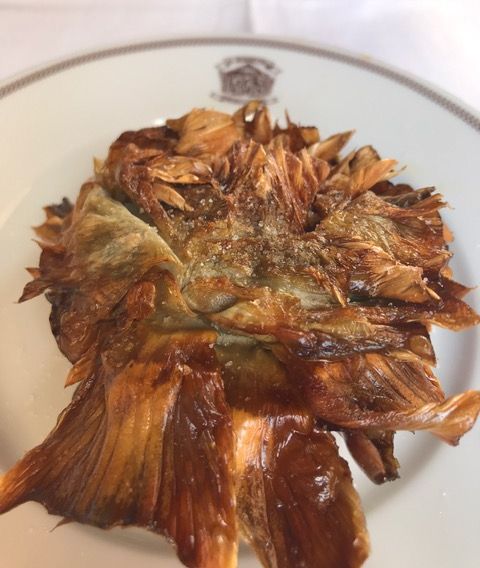
Our experience was very different. The artichoke did look something like a dried sunflower, but the petals disappeared, leaving behind a thin, oily skin. It was salty, much like the deep fried onions served at many American steak houses, but otherwise had no noticeable flavor. We each had a few bites and the set it aside.
On the other hand, the carbonara was delicious. Mary said it was “intoxicating – luscious and wonderfully indulgent. The simplicity of the dish is what makes it a winner for me. A bit of long pasta, with pancetta, eggs, Parmesan, olive oil and a bit of salt and pepper. I could eat it every day.”
An Unexpected History Lesson
After lunch, as we walked out of the Jewish Ghetto, we saw several of the stolpersteines – “stumbling stones”. These are bronze markers set in the street as memorials to Jews killed by the Nazis in World War II. We knew very little about them at the time we saw them, but have since learned more about their significance. The stones are placed in front of the individual’s home and records their name, date of birth, date of arrest and the date and place of their death.
There are 70,000 such stones in over 1200 locations across Europe, Russia and Ukraine, set as part of a large project by Gunter Demning, an artist from Cologne, Germany.
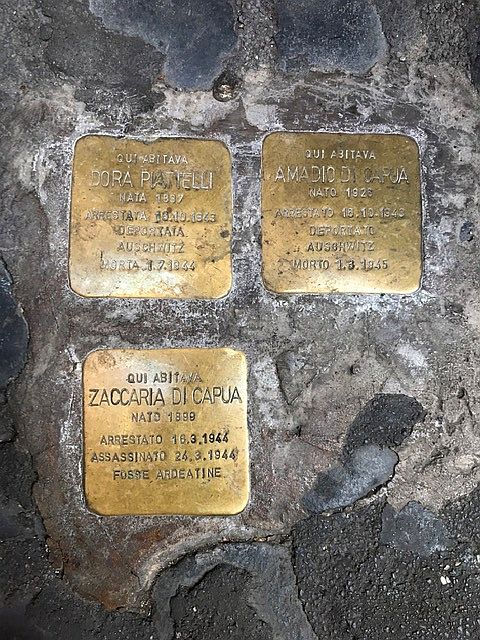
On October 16, 1943 over 1,000 Jews, including 200 children were arrested in Rome, most in the Jewish Ghetto. Only 16 returned from Auschwitz.
Learning the story of the Jews in Rome and the solpersteine project has been a sobering reminder of one of the darker moments in our human history.
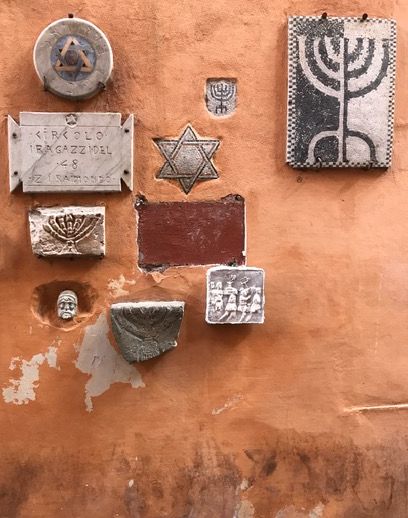
Some additional details
Here are several sources I found that described the Jewish Ghetto and the historical events that I mention above. I have not attempted to verify all the facts, but believe them to be correct. If you think otherwise, please add a comment below. I look forward to the conversation. – Mike
- Wikipedia – “The Roman Ghetto”, https://en.m.wikipedia.org/wiki/Roman_Ghetto
- “The Jewish Ghetto in Rome”, https://anamericaninrome.com/wp/2018/12/jewish-ghetto-rome/
- “October 16, 1943 and the Nazi Occupation of Rome”, https://anamericaninrome.com/wp/2018/10/october-16th-1943-and-the-nazi-occupation-of-rome/
- Jewish Ghetto neighborhood, https://www.wantedinrome.com/area/jewish-ghetto
- Gunter Demning and the “Stolpersteine” (Stumbling Stones) project: http://www.stolpersteine.eu/en/home/
Gunter Demning’s web site includes information on how to make a donation to support the project. Individual stumbling stones cost EU 120. We are planning to make a donation once we return home.
===============================================
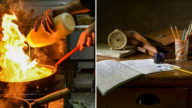
===============================================
